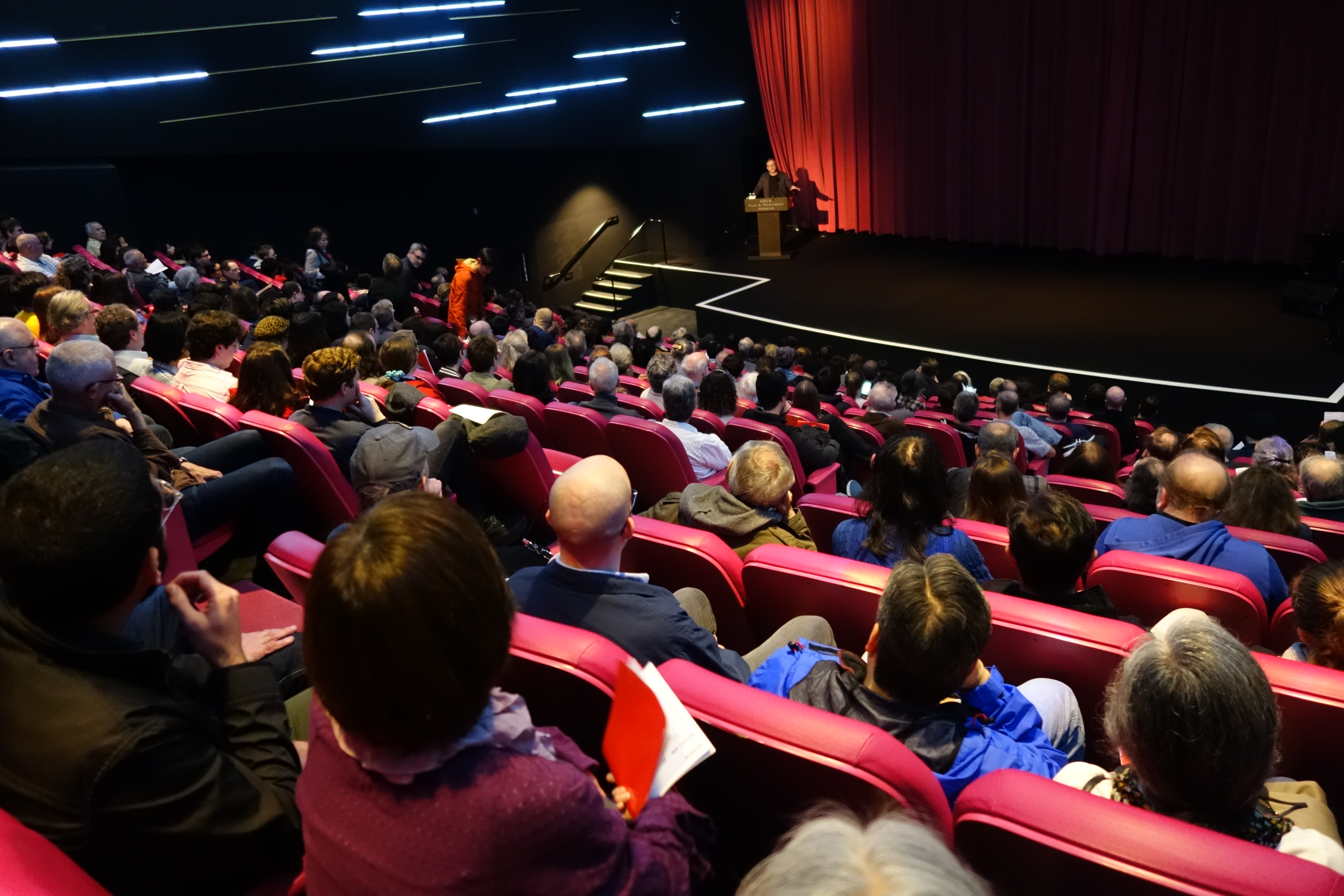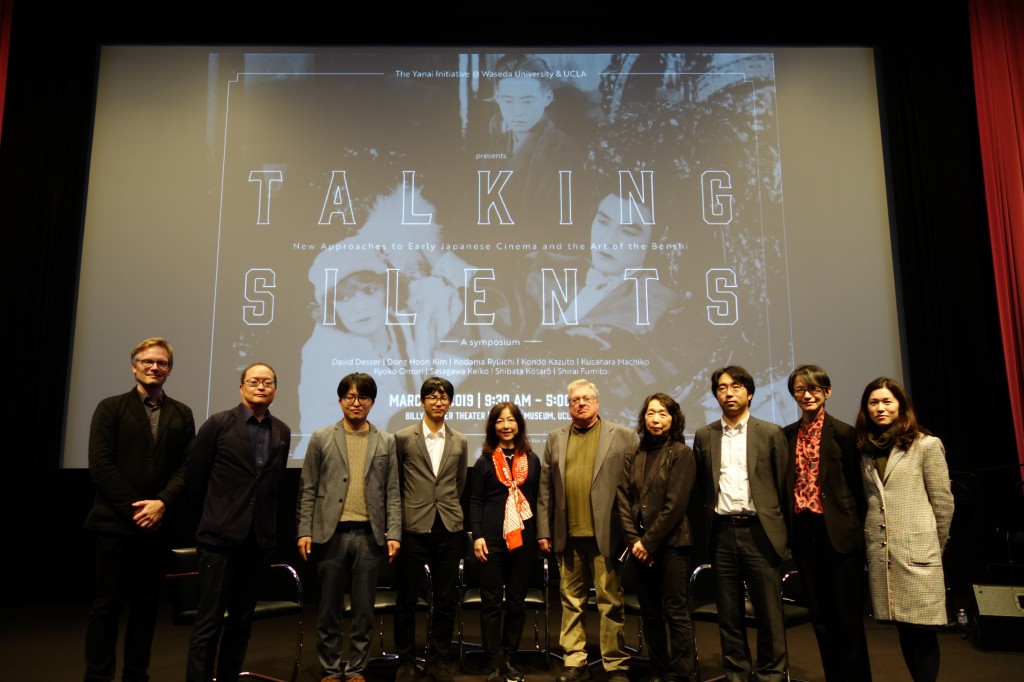Report
Film Screening “The Art of the Benshi”
International Symposium “Talking Silents: New Approaches to Early Japanese Cinema and the Art of the Benshi”
From March 1 to 3, 2019, a film screening, “The Art of the Benshi,” and an international symposium, “Talking Silents: New Approaches to Early Japanese Cinema and the Art of the Benshi,” took place at the Billy Wilder Theater of the University of California, Los Angeles (UCLA). The symposium was co-organized by UCLA and Waseda University’s Global Japanese Studies Model Unit of the Top Global University Project, with cooperation from the Tsubouchi Memorial Theatre Museum, Waseda University (Theatre Museum), and was part of the Tadashi Yanai Initiative for Globalizing Japanese Humanities.
These events illuminated various aspects of benshi, a development of the silent movie era unique to Japan who were speakers who provided narration for silent films. There was considerable attention from various corners of the media, including newspapers, such as The Wall Street Journal and the Los Angeles Times, and websites, such as Movie Walker.
■Film Screening: “The Art of the Benshi”
During the three-day film screening event “The Art of the Benshi,” there were a total of 15 showings of treasured silent movies across four programs. Eleven works were included in these showings. Audiences were drawn in by the brilliant performances of three benshi, Ichiro Kataoka, Raiko Sakamoto, and Kumiko Omori, and five musicians, Joichi Yuasa, Makiko Suzuki, Yuki Furuhashi, Kaname Tanbara, and Kisayo Katada. The venue was enveloped with excitement as a total audience of around 750 came to have the lavish experience—unparalleled even in modern Japan—of seeing each work shown accompanied by narration by the benshi and live performances by the musicians.

The film screening represented a new development in the joint research and academic screenings conducted at the Theatre Museum’s Collaborative Research Center for Theatre and Film Arts, where research into the Theatre Museum’s “Hirano Collection” of musical scores for movies of the silent era and showings of silent films with narration and musical accompaniment using the collection’s assets are underway. During each program of the event in Los Angeles, three or four of the 11 works—a diverse collection weaving together Japanese and American short and feature-length films—were shown. The works included three films by the master director of Japanese historical films Daisuke Ito, A Diary of Chuji’s Travels, The Sword that Slashes Human and Horse, and Blood Spattered Takadanobaba; Silence, an extant print of which was discovered in 2016; Liberty, a short by Laurel and Hardy and a work befitting the venue, as the UCLA Film & Television Archive is a major center for studies of the duo’s oeuvre; an early Japanese film from the Theatre Museum’s collection, Not Blood Relations; Dragnet Girl, directed by the master Yasujiro Ozu; and Kenji Mizoguchi’s Tokyo March.
The most salient feature of this event was that it was designed to have three benshi appear at each program, allowing the audience to experience the unique qualities of each, rather than merely listening to only a single benshi narrate. The same work was sometimes shown with narration by different benshi. This demonstrated how differences in the benshi‘s performances changed the movie-viewing experience and how this drew out the potentialities latent in each work. Additionally, Not Blood Relations and Jiraiya the Hero were shown on the third day with narration provided by a trio benshi in conversation. Since the 1920s and to the present, the style adopted by most benshi involves narrating movies’ stage direction and dialog as a single speaker. This conversational trading of lines back and forth is an older style, how benshi narrated films in the 1910s. Thus, it was a valuable experiment in the art of benshi that one would scarcely ever have the opportunity to experience even in Japan.

Furthermore, four works (Blood Spattered Takadanobaba, The Sword that Slashes Human and Horse, A Diary of Chuji’s Travels, and Not Blood Relations—all but the last period dramas) were shown with accompaniment by live-performed music selected from the historical scores included in the Hirano Collection. For the remaining seven works, members of the ensemble Colored Monotone, including Joichi Yuasa and Kaname Tanbara, provided musical accompaniment incorporating improvisation. The audiences were enchanted by a mixture of music, some of which included the shamisen and other traditional Japanese instruments and some of which gave expression to more modern Japanese musical sentiments. This was distinct from the orchestrations that typically accompany European and North American silent films.
The film screening event concluded with a rousing standing ovation; the narration by modern benshi, the music by modern musicians, and the sounds of historical scores—as well as treasured historical cinematic works and the reactions of the American audiences—had reverberated figuratively together, each adding more to the experience.

■International Symposium
In addition to the film screening event, an international symposium, “Talking Silents: New Approaches to Early Japanese Cinema and the Art of the Benshi,” was held on March 2. Michael Emmerich (Associate Professor, UCLA) and Junko Yamazaki (Assistant Professor, UCLA) served as moderators. Discussions were far-ranging, and the topics involved the benshi who were the principal subjects of the film screening event discussed above, musical accompaniment, movie theaters, the shadow puppet plays and kabuki that are part of the prehistory of benshi-accompanied film, cinema since the dawn of talkies, and initiatives to release materials in digital formats.
The first topic of discussion was the relationship between the culture of shadow puppet plays and kabuki—which formed the pre-history of, and background to, Japanese silent cinema—and later silent movies. Machiko Kusahara (Professor Emerita, Waseda University) described the culture of shadow puppet plays and magic lanterns in Japan, which served as the forerunners to cinema in the country. She included valuable documents and video clips in her presentation, which considered the relationship between pre-cinema visual culture and narration. Ryuichi Kodama (Professor and Associate Director of the Theatre Museum, Waseda University) considered the relationship between Japanese silent films and kabuki from multiple standpoints, including Edo-era literature, katarimono (musically accompanied narrative performances), and geza ongaku (music used for dramatic effect in kabuki stagings, with the musicians hidden from view). Next, there was a discussion about the relationship between Japanese cinema and speaking. First, David Desser (Professor Emeritus, University of Illinois) considered issues of speech in film, such as the narration found in a group of works, which included Stray Dog by Akira Kurosawa (whose elder brother was a benshi), that is reminiscent of the speaking performed by benshi. Finally, Kazuto Kondo (Post-Doctoral Fellow of the Japan Society for the Promotion of Science, Waseda University) discussed the topic of programs handed out at movie theaters. He described how, during the 1920s, as movie theaters proliferated and each picture house focused on differentiating itself from the competition, it was through the medium of these programs that movie theaters and audiences “spoke” to one another, leading to the development of forms of communication particular to theaters.

During the afternoon part of the symposium, the discussion focused on movie theaters’ practices regarding audio and music during the silent era (and subsequently). First, Kyoko Omori (Professor, Hamilton College) related the various forms in which research findings on the symposium’s topic were being presented, such as through the compilation of historical materials relating to the showing of silent movies—including those relating to benshi—in databases and 3D data providing virtual spaces inside those movie theaters of many decades ago. She thus demonstrated possibilities for modern ways of using research materials. Next, Kotaro Shibata (Research Associate, Waseda University Theatre Museum) considered how, even as cinematic musical accompaniments achieved a type of “westernization” everywhere from the 1910s onward, in Japan, the practice that developed was that of eclecticism—with a mix of western music, kabuki-style geza ongaku, biwa uta (narration accompanied by the playing of a lute-like instrument), and other genres. Keiko Sasagawa (Professor, Kansai University) noted how the tradition of narration of benshi during the silent era was passed down into the talky era and beyond in the form of movies whose plots were based on and which incorporated rōkyoku (a type of narrative song, also known as naniwabushi), primarily discussing such movies produced in the 1930s. This development in the history of cinema was particular to Japan. Finally, Fumito Shirai (Post-Doctoral Fellow of the Japan Society for the Promotion of Science, Kyoto University) discussed how musical-accompaniment scores imported from overseas were accepted in Japan and how they were combined with Japanese instruments and musical compositions when used. He employed research materials from the Hirano Collection, which were also used during the film screening event, as case studies.
At this symposium—attended by researchers active in Japan and the US—the central focus was on the narration of benshi, but the presentations and discussions were wide-ranging and incorporated various perspectives. The symposium thus shed light on various aspects of Japanese cinematic culture, including benshi narration. Additionally, through the combination of the film screening event and discussions of academic knowledge and views, various potential avenues for further research in this area of study were successfully brought into view.



